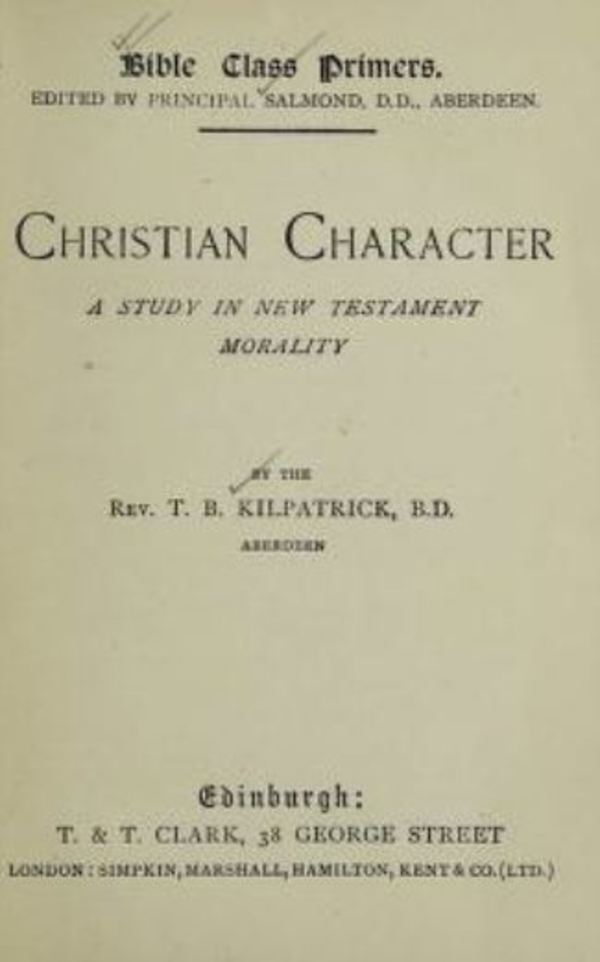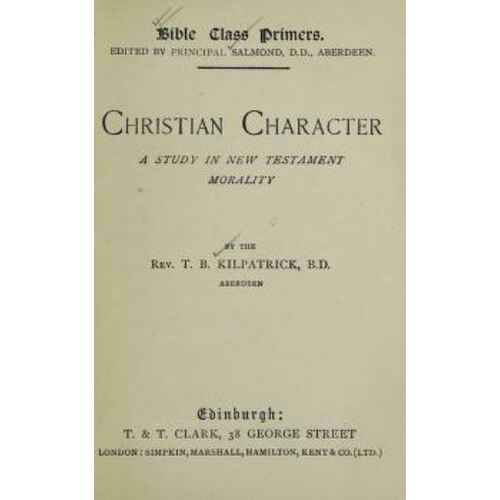
Source: Link
KILPATRICK, THOMAS BUCHANAN, Presbyterian minister, author, university professor, and social reformer; b. 27 Sept. 1857 in Glasgow, son of Daniel Ross Kilpatrick and Elizabeth Margaret Ritchie; m. first 21 April 1885 Anna M. K. Orr in Edinburgh, and they had a son and two daughters; m. there secondly 27 June 1899 Jane M. Binnie; d. 20 March 1930 in Toronto.
Thomas B. Kilpatrick was born into a Free Church family. His father, a minister in working-class Glasgow, was a leader of the evangelical revival there in 1859. Kilpatrick studied at the Glasgow Academy and the University of Glasgow, where leading British idealist philosopher Edward Caird reputedly considered him one of his finest students. He graduated in 1877 with first-class honours in mental philosophy. Kilpatrick graduated next in 1881 from the Free Church College in Glasgow; he then pursued further studies at the University of Jena in Germany. In 1882 he was ordained to the parish of Burntisland in Fife, Scotland. Free Church family connections ran deep for Kilpatrick. His first wife was the daughter of Free Church minister George Orr; his second wife was the daughter of Professor William Binnie of the Free Church College in Aberdeen.
Kilpatrick’s first published work appeared in Essays in philosophical criticism (London, 1883), which featured a new generation of philosophers educated by Caird and Thomas Hill Green of Oxford. The writers sought to apply idealist thinking to the most pressing problems in science, ethics, and religion. Kilpatrick’s essay dealt with the pessimism created by contemporary, individualistic philosophies that left people feeling alone, separated from God, nature, and each other. The task of religion was to proclaim the hope provided by the supreme principle of love. This principle, in Kilpatrick’s estimation, reached its ultimate expression in Christianity. Throughout his career he sought to promote this interpretation in the classroom, print, parish life, and church committees.
In 1888 Kilpatrick moved to Ferryhill Free Church in Aberdeen. The congregation almost doubled in size during his 11 years there and he gained a reputation for convincing the younger generation of the validity of Christian claims. He continued to write, and turned his attention to popular theology and ethics. In 1888 he edited a collection of sermons by English apologist Joseph Butler for a series of handbooks aimed at Bible classes and private students. His Christian character: a study in New Testament morality (Edinburgh, 1899) appeared in a series of Bible-class primers designed to make the results of scholarly study and progressive biblical and theological thought accessible to intelligent readers.
By the time Kilpatrick lectured during the summer session of 1898 at Manitoba College in Winnipeg, he was recognized as an important interpreter of the more traditional wing of the back-to-Christ movement in theology. This school of thought sought to reinterpret, not reject, traditional affirmations in the light of modern scholarship. It focused on the person of Christ rather than on doctrines or creeds, but found in the historical Christ one who was aware of his divinity and who was declared by the Resurrection to be the Son of God. This thinking harmonized an evangelistic piety, an idealistic world-view, and a devout approach to biblical criticism.
In 1899 Kilpatrick received an honorary doctorate from the Free Church College and accepted the invitation of Manitoba College to become professor of systematic theology and apologetics and a joint lecturer in philosophy. During his tenure there an influential group of Protestant ministers, including Principal William Patrick (who had followed Kilpatrick from Scotland in 1900) and Charles William Gordon*, promoted the idea of uniting Protestantism in Canada to ensure the continuing influence of Christianity in a rapidly changing dominion, especially in the cities and in the west. Kilpatrick’s enthusiastic support for church union rested on his belief that the context of a new country offered possibilities to create a synthesis of the best of the past through historical evolution guided by the spirit of God. In his view, the best was distinctly moral and Protestant. During debates over the Prohibition referendum in Manitoba in 1902, he publicly supported the Dominion Alliance for the Total Suppression of the Liquor Trade. The church had a duty to help purify politics, he later maintained. In his promotion in 1904 of a grand design for education in Canada, he was forced reluctantly to recognize the constitutional reality of separate schools. In a discussion in 1907 about Mormon immigration, he stated that “the greatest grief in Alberta is the Mormon settlement.”
In 1905 Kilpatrick had carried his vision of church unity to the University of Toronto’s Knox College, where he had been appointed professor of systematic theology. He and Principal Alfred Gandier formed the continuing core of Knox’s faculty over the time it took Canadian Presbyterians, Methodists, and Congregationalists to work through the details and the battles involved in creating the United Church of Canada in 1925. At the same time Kilpatrick continued to venture opinions on public matters and write popular theology. For a series of dictionaries and encyclopedias edited by James Hastings, he authored articles on conscience, philosophy, the character of Christ, the Incarnation, the anger of God, benevolence, salvation, soteriology, and suffering. In addition, he published New Testament evangelism (Toronto, 1911), a set of lectures he gave to the Knox alumni conference of 1910, with appendices by John George Shearer, secretary of the Board of Social Service and Evangelism of the Presbyterian Church in Canada. This book was designed to advance the church’s program for liberal evangelism, which combined traditional evangelistic appeal with the promotion of progressive social reform. Kilpatrick’s social ethic embraced Victorian middle-class values as applied to the new conditions of immigration, industrialization, and urbanization in Canada. He was an influential member of Shearer’s board for many years, participated in a number of evangelistic campaigns, and taught the course on evangelism at Knox. In recognition of his work, he was made a doctor of sacred theology in 1910 by the Hartford Theological Seminary in Connecticut.
Kilpatrick believed that his ideal of an integrated and unified nation required a united Protestantism. Separation should cease, he argued, unless the maintenance of some vital element of Christian salvation was at issue. He sat on the joint committee on church union from 1906 to 1925, and was an influential member of the committee that drafted the doctrinal section of the Basis of Union. In 1919 he wrote that the church needed to consolidate its resources to serve God, not as a machine, but as “an organic whole, a living organism, a spiritual community, whose creative centre is Christ, whose vital power is the Divine spirit, whose members are held together by one faith and love.” Especially in the aftermath of World War I, he believed, the ideals of the church needed strong and unified promotion. “War-devastated, distracted by animosities, misled by statesmen, disillusioned as to democracy, rendered desperate by failure of schemes and plans, treaties and conventions, alliances and leagues, the world needs that God . . . who is Love,” he would write in 1928.
With the creation of the United Church, Kilpatrick and his professorial colleagues left Knox and moved to the college of the new church, eventually named Emmanuel College. Ill health, however, led to his retirement in 1926. He died four years later at his home at 134 St George Street, near the university, from which all three of his children had graduated. Elizabeth Margaret Ritchie, after service overseas as a nurse in 1918–19, taught at Branksome Hall girls’ school in Toronto; Dorothy Hamilton, following several years as a missionary in India, became a dean of women at the university; and George Gordon Dinwiddie, a chaplain during the war, later served as principal of the United Theological College in Montreal.
Thomas Buchanan Kilpatrick’s publications include “Pessimism and the religious consciousness,” in Essays in philosophical criticism, ed. Andrew Seth [Pringle-Pattison] and R. B. Haldane (London, 1883), 246-77; Counsels to a young missioner (Toronto, 1909); The Kootenay campaign: evangelism and moral reform, April and May, 1909, co-written with J. G. Shearer (Toronto, 1910); “William Patrick: 1852-1911; an appreciation,” Presbyterian (Toronto), new ser., 19 (July-December 1911): 359-60; “The end of a long ministry,” Presbyterian, new ser., 25 (July-December 1914): 175; “The church in the twentieth century,” Constructive Quarterly (New York), 7 (1919): 400-33; and Our common faith; with a brief history of the church union movement in Canada by Kenneth H. Cousland (Toronto, 1928). In addition, he edited Joseph Butler, Sermons: sermons I, II, III, upon human nature, or man considered as a moral agent (Edinburgh, [1888]), and contributed a number of entries to the following theological reference works edited by James Hastings: A dictionary of Christ and the Gospels (2v., Edinburgh, 1906-8), 1: 281-91, 796-813; A dictionary of the Bible; dealing with its language, literature, and contents, including the biblical theology (5v., Edinburgh, 1906), 1: 468-75; 3: 848-54; Encyclopædia of religion and ethics (13v., Edinburgh, 1908-26), 1: 477-82; 2: 474-79; 11: 110-31, 694-725; 12: 1-10.
AO, RG 22-305, no.65419. General Register Office for Scotland (Edinburgh), Blythswood (Glasgow), reg. of births, 27 Sept. 1857; Newington (Edinburgh), reg. of marriages, 21 April 1885; St Andrew (Edinburgh), reg. of marriages, 27 June 1899. UTA, A1973-0026/201(38)-(40). Globe, 22 March 1930. Canadian annual rev., 1902, 1907. Canadian men and women of the time (Morgan; 1912). B. J. Fraser, “Christianizing the social order: T. B. Kilpatrick’s theological vision of the United Church of Canada,” Toronto Journal of Theology, 12 (1996): 189-200; Church, college, and clergy: a history of theological education at Knox College, Toronto, 1844-1994 (Montreal and Kingston, Ont., 1995); The social uplifters: Presbyterian progressives and the Social Gospel in Canada, 1875-1915 (Waterloo, Ont., 1988). Standard dict. of Canadian biog. (Roberts and Tunnell). Univ. of Toronto Monthly, 30 (1929-30): 376.
Cite This Article
Brian J. Fraser, “KILPATRICK, THOMAS BUCHANAN,” in Dictionary of Canadian Biography, vol. 15, University of Toronto/Université Laval, 2003–, accessed January 10, 2026, https://www.biographi.ca/en/bio/kilpatrick_thomas_buchanan_15E.html.
The citation above shows the format for footnotes and endnotes according to the Chicago manual of style (16th edition). Information to be used in other citation formats:
| Permalink: | https://www.biographi.ca/en/bio/kilpatrick_thomas_buchanan_15E.html |
| Author of Article: | Brian J. Fraser |
| Title of Article: | KILPATRICK, THOMAS BUCHANAN |
| Publication Name: | Dictionary of Canadian Biography, vol. 15 |
| Publisher: | University of Toronto/Université Laval |
| Year of publication: | 2005 |
| Year of revision: | 2005 |
| Access Date: | January 10, 2026 |



